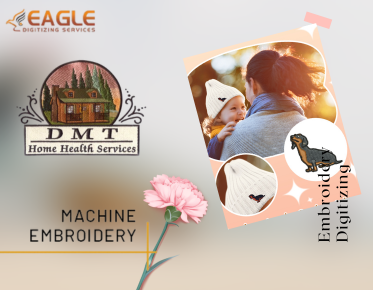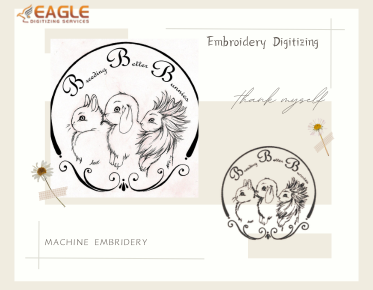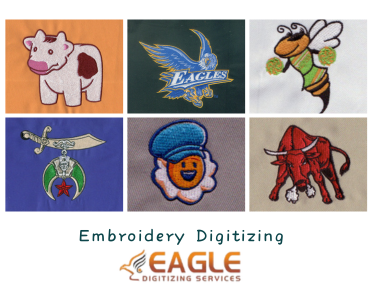Leather Love: Mastering Monogramming with Embroidery
Monogramming leather is a timeless way to add a personal touch to your accessories, making them uniquely yours. From leather bags to wallets and belts, a well-placed monogram can elevate an ordinary item into a cherished keepsake. Let's delve into the intricate process of monogramming leather using embroidery, ensuring each stitch is perfect.
The
Appeal of Monogramming Leather
Why Monogram Leather?
Leather, known for its durability and classic appeal, becomes even
more special when personalized with a monogram. Monogramming adds an element of
sophistication and individuality, making it an ideal gift or personal
statement.
Popular Leather Items for
Monogramming
Common items for leather monogramming include wallets, handbags, belts, keychains, and luggage tags. These items are not only functional but also stylish, making them perfect canvases for your monogrammed creations.
Choosing
the Right Leather for Embroidery
Types of Leather Suitable for
Embroidery
Not all leathers are created equal when it comes to embroidery.
Full-grain leather, top-grain leather, and vegetable-tanned leather are
excellent choices. These types provide a sturdy yet smooth surface that holds
stitches well.
Tips for Selecting High-Quality
Leather
When selecting leather, look for pieces that are smooth, supple, and free from imperfections. High-quality leather will have a consistent color and texture, ensuring your embroidery stands out beautifully.
Preparing
Your Leather for Monogramming
Cleaning and Conditioning
Leather
Before you start, clean your leather to remove any dust or oils. Use a
leather cleaner suitable for your leather type, followed by a conditioner to
keep it supple. This step ensures a clean surface for your embroidery.
Cutting Leather to Size
If you're working with a larger piece of leather, cut it to the desired size. Use a sharp rotary cutter and a straight edge for clean cuts. This will make handling and hooping the leather easier.
Selecting
Your Monogram Design
Choosing Fonts and Styles
Choose a font and style that suits the item's purpose and the
recipient's personality. Serif fonts convey elegance, while sans-serif fonts
offer a modern look. Script fonts can add a touch of vintage charm.
Customizing Your Monogram
Customize the monogram by adjusting the size and adding decorative elements. This personalization ensures the monogram is unique and fits perfectly on your leather item.
Setting
Up Your Embroidery Machine
Selecting the Right Machine for
Leather
Not all embroidery machines are equipped to handle leather. Ensure
your machine has the capability to embroider on thicker materials. Machines
with a high foot lift and powerful motors are ideal.
Adjusting Machine Settings for
Leather
Adjust your machine settings for optimal performance on leather. Lower the stitch speed to avoid skipping stitches, and adjust the tension to accommodate the thickness of the leather.
Choosing
the Right Needles and Threads
Best Needle Types for Leather
Use needles specifically designed for leather, such as chisel-point
needles. These needles cut through leather cleanly, reducing the risk of
tearing.
Thread Choices for a Durable
Monogram
Choose a strong, durable thread like polyester or bonded nylon. These threads withstand the wear and tear that leather items often endure.
Using
Stabilizers on Leather
Types of Stabilizers for Leather
Stabilizers are crucial when embroidering on leather. Tear-away or
cut-away stabilizers provide the necessary support. Adhesive stabilizers can
also be useful for holding the leather in place.
How to Apply Stabilizers
Correctly
Apply the stabilizer to the back of the leather, ensuring it covers the entire area to be embroidered. Secure it firmly to prevent shifting during stitching.
Hooping
Leather for Embroidery
Proper hooping is essential for achieving precise embroidery results
on leather, ensuring stability and minimizing distortion.
Importance of Proper Hooping
Correct hooping maintains even tension across the leather surface,
preventing puckering and ensuring consistent stitching. It supports the
leather's structure and allows the embroidery machine to accurately follow the
design without slipping or shifting.
Methods for Hooping Leather
Use magnetic or adhesive hoops designed for leather to securely hold the material without leaving marks or damaging the surface. Adjust the tension of the hoop to accommodate the leather's thickness and ensure a snug fit that supports the embroidery process.
Creating
a Test Stitch
Importance of Testing on Scrap
Leather
Always run a test stitch on a scrap piece of the same leather. This
helps you adjust settings and see how the leather responds to stitching,
preventing mistakes on the final piece.
Adjusting Settings Based on Test
Results
Use the test stitch results to fine-tune your machine’s settings.
Adjust tension, stitch length, and stabilizer as needed to achieve the best
results.
Types of Embroidery Stitches for
Leather
Embroidering on leather requires stitches that not only secure the
thread but also enhance the leather's natural beauty and resilience.
●
Basic Outline and Backstitch: The basic outline
stitch provides a foundation for outlining shapes and creating borders on
leather, ensuring clean edges and precise detailing. Backstitching reinforces
these outlines with strong, overlapping stitches, which are ideal for outlining
intricate designs and adding definition.
●
Satin Stitch and Fill Stitches: Satin stitches
cover larger areas with smooth, continuous threads, creating a satin-like
finish that highlights the leather's smooth surface. Fill stitches, such as
seed stitches or long and short stitches, add texture and density to
embroidered areas, filling spaces between outlines with intricate patterns and
enhancing visual interest.
● Decorative Stitches for Leather: Explore decorative stitches like chain stitches, French knots, or bullion stitches to add ornate details and texture to leather embroidery. These stitches create raised motifs and intricate patterns, transforming plain leather into a canvas of artistic expression.
Avoiding
Common Mistakes
Preventing Skipped Stitches and
Thread Breaks
Check your needle regularly and replace it if it becomes dull. Skipped
stitches often result from a blunt needle or incorrect tension settings.
Dealing with Tension Issues
Adjust the upper and bobbin thread tension to find the sweet spot where the stitches look even on both sides of the leather. Too tight or too loose tension can cause puckering or uneven stitches.
Embroidering
Your Monogram
Step-by-Step Guide to Stitching
- Secure your leather in the hoop with stabilizer backing.
- Load your monogram design into the machine.
- Start stitching slowly, monitoring the process to ensure smooth
operation.
- Pause periodically to check for any issues and make adjustments
if necessary.
Tips for Precision and
Consistency
Maintain a steady rhythm and avoid sudden movements that could shift the leather. Consistent speed and careful monitoring ensure high-quality results.
Finishing
Touches
Removing Stabilizers Safely
Carefully remove the stabilizer without pulling or stretching the
leather. Use a small pair of scissors to trim away any excess stabilizer close
to the stitches.
Cleaning Up Loose Threads
Use sharp embroidery scissors to trim any loose threads. Be careful not to cut any of the embroidery stitches.
Conditioning
Leather After Embroidery
Reconditioning Leather
Post-Stitching
After embroidery, recondition the leather to keep it supple. Apply a
soft cloth to the leather conditioner, working it into the leather gently.
Products to Use for Leather Care
Use high-quality leather care products, such as beeswax-based conditioners or leather balms, to nourish and protect the leather.
Adding
Extra Details
Incorporating Beads and Sequins
in Leather Embroidery
Enhance leather embroidery with beads and sequins for added texture,
sparkle, and dimension.
Tools and Techniques for Beading
on Leather
Beading needles and strong, flexible beading thread are used to
securely attach beads to leather. Incorporate bead embroidery stitches like
couching or picot edges to highlight beads and prevent them from loosening over
time.
Attaching Sequins Securely
Sew sequins onto the leather using small, discreet stitches that
anchor each sequin firmly in place. Experiment with sequin sizes and shapes to
create eye-catching patterns and accents on leather embroidery projects.
Design Ideas with Beads and
Sequins
Create intricate motifs, borders, or embellishments by combining beads and sequins with traditional embroidery stitches on leather. Mix textures and colors to achieve contrast and visual interest, transforming plain leather into a statement piece.
Maintaining
Your Embroidered Leather
Care Tips for Long-Lasting
Embroidery
Keep embroidered leather items away from direct sunlight and moisture.
Regularly condition the leather to maintain its softness and prevent cracking.
Storing Embroidered Leather
Items
Store leather items in a cool, dry place. Use dust bags or wrap them in acid-free tissue paper to protect them from dust and light.
Creative
Project Ideas
Monogrammed Leather Accessories
Consider creating monogrammed accessories like wallets, belts, keychains,
and phone cases. These personalized items make thoughtful gifts and stylish
personal accessories.
Personalized Leather Gifts
Monogrammed leather gifts are perfect for special occasions. Think custom leather journals, handbags, or even a personalized leather jacket for a unique touch.
Troubleshooting
Issues
Fixing Common Embroidery
Problems
If you encounter problems like skipped stitches or thread breaks,
recheck your needle and thread tension. Ensure the stabilizer is properly
applied and the leather is securely hooped.
When to Seek Professional Help
For persistent issues or if the leather is particularly valuable, consider seeking professional embroidery services. They have the knowledge and tools to solve difficult issues.
Tips
from Experienced Embroiderers
Expert Advice for Beginners
Begin with modest designs and progressively progress to more
sophisticated projects. Patience and practice are key to mastering leather
embroidery.
Lessons Learned from Advanced
Projects
Advanced embroiderers emphasize the importance of meticulous preparation and testing. Every leather piece is unique, so continuous learning and adaptation are essential.
Exploring
Advanced Techniques
Using Metallic Threads on
Leather
Metallic threads can add a luxurious touch to your leather embroidery.
Use them sparingly and ensure your machine is compatible with metallic threads
to avoid breakage.
Experimenting with Different
Stitch Patterns
Try different stitch patterns to add texture and dimension to your designs. Combining various stitches can create unique and visually appealing monograms.
Monogramming leather using embroidery is a rewarding process that
results in beautiful, personalized items. By following these steps and tips,
you can create stunning monogrammed leather pieces that stand the test of time.



